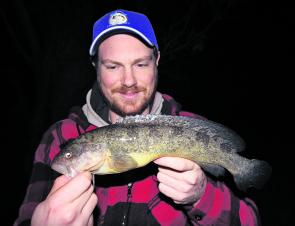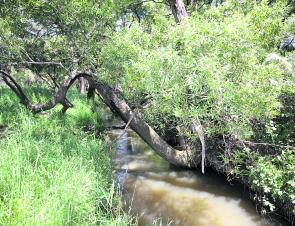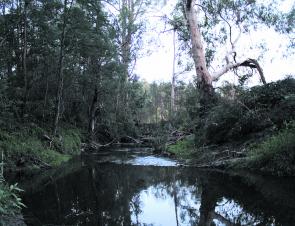Lurking in the pools of Victoria’s creeks and streams is a secretive, yet ferocious native predator patiently waiting to launch an assault on the next unfortunate worm to be swept into its path. River blackfish are a species often sought after by freshwater anglers and, to those who know how to find the big ones, they are a prized catch well worthy of targeting.
If you’re unsettled by the idea of navigating your way through dense scrub in pitch black darkness with the eerie sounds of nocturnal critters foraging around you, then perhaps catching blackfish is not for you. Although you can work hard to occasionally snag one during the day, the feeding of river blackfish is almost completely a nocturnal affair. I remember my first experiences; lining the banks of the Carlisle River at dusk with my dad, uncle and cousins, impatiently waiting out the last bite-less hour of daylight until complete darkness set in and all rods bent in unison. There’s simply no doubt that if your serious about catching blackfish, you need to do so in the dark.
Before you head out for a night session you need to think seriously about how you’re going to make your trip enjoyable in complete darkness. It’s easy in theory to just pack a torch and go for it but when you end up snagged or need to re-tie your rig the reality sets in; night fishing is horribly tedious for the unprepared.
First of all, a lantern can be good but a head torch is the ultimate tool for night fishing visibility as you won’t have any time to re-position your lantern while you’re wrestling a blackfish from its snaggy lair. Another great invention is the little glow stick that you can attach to your rod tip. You might think that these are un-necessary when you have a powerful torch strapped to your head but they really do make even the tiniest twitches in your rod tip glaringly obvious.
I’ve seen good river blackfish caught in many waterways of greatly varying size. From the main arm of the Upper Yarra right down to its smallest tributary, blackfish are a versatile species that inhabit numerous river systems in Victoria and are even found to a lesser extent, in South Australia and southern New South Wales.
Contrary to what you might expect, it’s been my experience that the biggest fish come from the smallest creeks. I learnt the full extent of this not long ago when I went out to fish a small tributary of the Yarra with local expert James Galloway.
Now I used to think that I fished small creeks for blackfish but I couldn’t believe the tiny, trickle of a stream that we pulled up at. In a waterway that is barely a metre wide and often not a metre deep we caught some of the biggest blackfish I’ve ever seen and we caught them consistently. The trick in these little creeks is to walk the banks until you come across a hole that’s deep enough that you can’t see the bottom; add an undercut bank or a submerged branch to the mix and you’ve found a spot that’s sure to hold a blackfish or two.
Big, fast flowing rivers like the Upper Yarra and wide sections of the Gellibrand are well known to hold good blackfish, but require a little more legwork between spots. You really need to search for areas where the water slows and eddies; these often occur on sharp bends in the river. A favourite spot of mine in the Yarra is a bend of the river near Woori Yallock where the water naturally slows. In addition to this, a big fallen tree slows the flow down even more as well as providing perfect blackfish habitat; this is the kind of ideal scenario you need to be looking for when picking spots in a wide, fast flowing section of river.
Blackfish are opportunistic in their predation so pretty much any bite sized critter that goes floating by is on the menu. Bait that is tried, tested and proven to work, are worms and small yabbies.
Worms are without doubt the most versatile and readily available bait around. Whether drifting them for trout, bobbing them for goldens or just using them to pick off a few pesky carp you’ll find that most freshwater anglers began their passion for fishing with the humble worm. There’s a very good reason for this, all freshwater species love them and river blackfish are certainly no exception.
There are many types of worm available these days; from the little garden variety you can dig up in your back yard to the much larger scrub worms you can pick from your local tackle shop, they will all do the trick to some extent. My preferred technique is to load up a hook with two or three medium sized worms to really try and achieve maximum wiggle and draw the attention of hungry blackfish.
When you’re serious about bypassing the nibbles of smaller blackfish to go straight for the 40cm+ models, it’s time to put a yabby on your hook. Anything in the size range of 30-60mm is a suitable yabby-bait for an adult blackfish. The biggest concern when fishing live yabbies is that they will understandably go for cover in an attempt to hide from the very fish that you’re angling for. One way to combat this, as cruel as it may sound, is to remove the limbs of yabby leaving it unable to burry itself and an easy target for a waiting predator. If you don’t have the heart to do this, a simple lift of your rod tip every minute or so will raise your yabby from the leaves and mud to make sure that it’s always on show.
I draw many comparisons between the behaviours of river blackfish and another Australian favourite, the mighty Murray cod. The way the two live a solitary existence held up tight in heavy cover, patiently waiting to launch a blistering attack on their next unsuspecting meal makes them similar indeed. Even the way they appear with the mottled green camouflage skin, rounded paddle tail and big gummy lips really makes me wonder how far removed the two species are on the evolutionary scale.
In much the same way as you would position a bardi grub or cast a spinnerbait right up hard against a submerged log, you want to get in nice and close to the snags and undercut banks for best results on blackfish. In most cases the best option will be swinging underarm cast due to the size of the creeks you’ll be fishing, and the dense scrub that tends to surround all the best blackfishing haunts.
You can use any current flow that may be present to your advantage by dropping your bait slightly upstream of a good looking snag and allowing it to drift right underneath the branches and into the hotspot.
I’m sure you can tell having read this article that chasing big river blackfish is a pastime that excites me to no end. It boggles my mind to know that so many anglers are oblivious to the awesome fishing experience that waits for them in these creeks, so do yourself a favour and head out to the Upper Yarra and Gellibrand systems for some night blackfishing action.
1
James Galloway with a ripper river blackfish taken on a live yabby.
2
Not all Victorian creeks hold monster blackfish like this but if you manage to catch one, there’s bound to be others nearby.
3
The author with a solid river blackfish caught in small tributary of the yarra.
4
Large river blackfish like this one are often caught in water less than 1m deep.
5
This dense, snaggy terrain makes for perfect river blackfish habitat.
6
Undercut banks like this are what you need to look for when picking sports to stop for a cast.
7
This healthy river blackfish caught with a small worm on a summer’s night.
8
You can use any current flow to your advantage by dropping your bait slightly upstream of a good looking snag and allowing it to drift right underneath the branches and into the hotspot.
Reads: 10428











